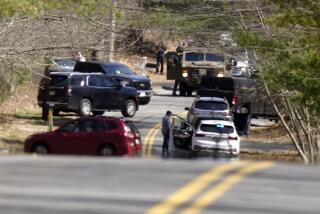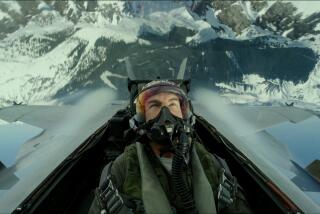U.S. Found to Have Eased Way for Iraqi Supergun
- Share via
WASHINGTON — The Bush Administration approved export licenses for computers and software that helped design Iraq’s notorious supergun and a ballistic missile capable of reaching Israel and other Middle East countries, according to documents and congressional investigators.
The export license for the computers was granted in the fall of 1989 to a Maryland company controlled by artillery wizard Gerald Bull, who was assassinated six months later outside his apartment in Belgium.
Often called the world’s greatest artillery designer, Bull had ties to U.S. intelligence and had served time in jail for violating U.S. export laws.
A prototype of the supergun designed by Bull for Iraq was discovered in the mountains north of Baghdad after the Persian Gulf War. United Nations inspectors said the 360-foot-long howitzer had been tested and was capable of firing nuclear, chemical and biological warheads.
The Commerce Department’s approval for export of technology used by Bull adds a new element to the campaign debate over whether U.S. export policies played a role in building up Iraq’s military arsenal. Critics have accused the Administration of permitting Iraq to obtain sensitive U.S. equipment as part of its effort to influence the regime of Saddam Hussein.
After claiming for months that no U.S. material was used in Iraq’s weapons program, President Bush acknowledged last week that some U.S. technology sold for commercial uses had been shifted illegally by Iraq to military programs.
Previous disclosures have shown that U.S. technology was used in Iraqi nuclear and chemical weapons programs. Documents provided to The Times show for the first time that U.S. technology also played a role in designing the supergun and, according to sources, refining Iraq’s long-range ballistic missile.
Bull’s Maryland company claimed in its application for a license to export the computers that they were destined for Iraq’s state automotive factory.
However, a separate license request for the software said the computers would be used in Belgium for “analysis of designs for military and heavy construction vehicles, lorries, satellites, missiles.”
Sources familiar with Bull’s operations have told congressional investigators and The Times that the computers designed elements of the supergun and the ballistic missile, which was test-fired by Iraq in late 1989 and was also being refined when Bull was murdered.
“It was a surprise to me when the government approved the license for the computers,” said one former Bull associate in an interview Monday. “It appeared that the United States would have exercised more prudence.”
Rep. Henry B. Gonzalez (D-Tex.), who has been investigating the Administration’s Iraq policy, is scheduled to describe details of the Bull episode today at a hearing of the Senate Banking, Housing and Urban Affairs Committee.
Brent Scowcroft, Bush’s national security adviser, and former Commerce Secretary Robert A. Mosbacher have ignored invitations from the Banking Committee to appear as witnesses at the hearing, according to a staff member of the panel.
In March, 1990, Bull was shot to death outside his Brussels apartment. The killer shot the 62-year-old scientist twice in the back of the skull but did not take $20,000 in his pockets.
The murder remains unsolved. Bull’s family has charged that it was carried out by Israel in retaliation for Bull’s work for Iraq. Israel was particularly alarmed by the supergun, but its government has denied any involvement in the murder.
Two weeks after Bull’s death, British customs agents seized eight huge steel tubes designed to form a 180-foot howitzer barrel. Labeled oil pipes, they were awaiting shipment to Iraq. Additional components were found elsewhere in Europe.
Bull’s Space Research Corp. had developed extended-range artillery shells in the 1960s and 1970s for the Canadian and U.S. military. He also sold $30 million worth of arms to South Africa, a violation of U.S. export laws that led to his imprisonment for six months in 1980. A congressional report later concluded that Bull had met the South Africans through a CIA official.
After his release, Bull moved Space Research Corp. to Brussels. He also opened an affiliate with the same name in Baltimore, headed by his son, Michael.
The Baltimore company applied for an export license in 1989 for two Iris super 380 computers and associated hardware with a total cost of $161,080, according to documents. The company said the computers were for Iraq’s State Enterprise for Automotive Industries.
The license was approved on Sept. 22, 1989. Because of the sophistication of the computers, the approval specified that they could not be used for nuclear purposes.
A few months earlier, Swanson Analysis Systems in Houston, Pa., had received U.S. approval to sell software for the Iris computers to Bull’s Brussels company.
That application said the computers would be used to test such military goods as missiles and military vehicles for stress. It specified that the software was bound for Belgium, a permissible destination.
“We sought and were granted the appropriate licenses,” said John Swanson, the company’s president. “Our contract said that the technology could not be exported to any other country.”
Sources close to Bull’s operation said the computers and software were used both in Belgium and Iraq to work on the supergun and Iraq’s long-range missile. They also said the computers helped design self-propelled howitzers for Iraq’s army.
A spokeswoman for the Commerce Department’s Bureau of Export Administration said she could not comment on either license because of privacy laws.
Intelligence documents indicate that work began on the supergun in 1988 and information about the project circulated in intelligence circles in 1989 and 1990. On Nov. 6, 1989--less than two months after the computers were approved for export--a CIA report identified Space Research Corp. as a component of Iraq’s worldwide arms-buying network.
After the Gulf War, Iraqi officials initially denied possessing a supergun. However, they later acknowledged work on the project and U.N. inspectors found a tested prototype and components for four more guns. They were later destroyed by the U.N. team, as were the components of Iraq’s ballistic missile program.
More to Read
Sign up for Essential California
The most important California stories and recommendations in your inbox every morning.
You may occasionally receive promotional content from the Los Angeles Times.











